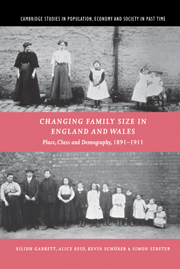Book contents
- Frontmatter
- Contents
- List of figures
- List of tables
- Preface and acknowledgements
- 1 Introduction
- 2 Locations for study
- 3 Studying locations
- 4 Infant and child mortality from the 1911 census
- 5 Fertility and fertility behaviour 1891–1911
- 6 The national picture
- 7 Class, place and demography: the mosaic of demographic change in England and Wales from Waterloo to the Great War
- Appendices
- References
- Index
- Cambridge Studies in Population, Economy and Society in Past Time
2 - Locations for study
Published online by Cambridge University Press: 05 January 2010
- Frontmatter
- Contents
- List of figures
- List of tables
- Preface and acknowledgements
- 1 Introduction
- 2 Locations for study
- 3 Studying locations
- 4 Infant and child mortality from the 1911 census
- 5 Fertility and fertility behaviour 1891–1911
- 6 The national picture
- 7 Class, place and demography: the mosaic of demographic change in England and Wales from Waterloo to the Great War
- Appendices
- References
- Index
- Cambridge Studies in Population, Economy and Society in Past Time
Summary
Introduction
As pointed out in the introductory chapter, while considerable progress has been made in charting and understanding the progress and nature of the declines in fertility and infant mortality in the late nineteenth and early twentieth centuries, the lack of data on the family building experiences of individual couples has constrained researchers' ability to understand fully the network of factors encouraging and enabling the population of England and Wales to have fewer, healthier children. With the civil registers of births, marriages and deaths closed to researchers, there has been little opportunity to undertake the detailed analysis of child bearing and rearing patterns possible for earlier centuries through the technique of ‘family reconstitution’.
One source which has been repeatedly plundered for information on the initiation and acceleration of fertility decline and infant survival has been the published reports from the 1911 Fertility Census authored by T. H. C. Stevenson. By using the data on ‘children born alive’ and ‘children dead’ supplied by individual couples, carefully discarding those married women who were not living with their husbands on census night, and standardising his measures of fertility and child survival to remove any distorting effect arising from differences in the average age at marriage or in the average marital duration of mothers, Stevenson was able to demonstrate occupational and spatial variations in both fertility and child survival.
- Type
- Chapter
- Information
- Changing Family Size in England and WalesPlace, Class and Demography, 1891–1911, pp. 24 - 55Publisher: Cambridge University PressPrint publication year: 2001



